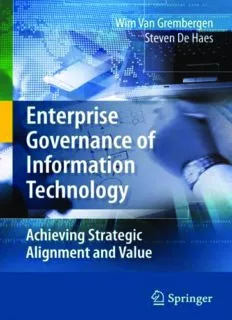
Enterprise governance of information technology: achieving strategic alignment and value PDF
Preview Enterprise governance of information technology: achieving strategic alignment and value
Wim Van Grembergen Steven De Haes l Enterprise Governance of Information Technology Achieving Strategic Alignment and Value 1 3 WimVanGrembergen StevenDeHaes UniversityofAntwerp UniversityofAntwerp UniversityofAntwerpManagement UniversityofAntwerpManagement School School SintPauwels,Belgium Malle,Belgium [email protected] [email protected] ISBN978-0-387-84881-5 e-ISBN978-0-387-84882-2 DOI10.1007/978-0-387-84882-2 LibraryofCongressControlNumber:2008936215 #SpringerScienceþBusinessMedia,LLC2009 Allrightsreserved.Thisworkmaynotbetranslatedorcopiedinwholeorinpartwithoutthewritten permissionofthepublisher(SpringerScienceþBusinessMedia,LLC,233SpringStreet,NewYork, NY10013,USA),exceptforbriefexcerptsinconnectionwithreviewsorscholarlyanalysis.Usein connectionwithanyformofinformationstorageandretrieval,electronicadaptation,computer software,orbysimilarordissimilarmethodologynowknownorhereafterdevelopedisforbidden. Theuseinthispublicationoftradenames,trademarks,servicemarks,andsimilarterms,evenifthey arenotidentifiedassuch,isnottobetakenasanexpressionofopinionastowhetherornottheyare subjecttoproprietaryrights. Printedonacid-freepaper springer.com Advance Praise ‘‘Atlastwehaveasolidlyresearch-basedtextontheEnterpriseGovernanceof ITthatsuccessfullyfusesbusinessandITperspectives.Withitsemphasisonthe creationofbusinessvalue,andontheuseofrelevantmetrics,thisbookoffersa distinctive view of these key processes. The authors, whose reputation and experience in the field is second to none, have created a guide to the strategic managementofITthatwillbeanessentialsourceformanagers.’’ ProfessorJamesW.Bryant CentreforIndividual&OrganisationalDevelopment SheffieldHallamUniversity UnitedKingdom ‘‘ITgovernanceisahottopictodayandthisbookprovidesawealthofpractical andusefulinformation.Regardlessofwhetheryouareconcernedaboutcom- plianceissues,orworriedaboutthealignmentofyourITinvestment withthe corporategoals,thisbookwillprovideguidancetoassistyourefforts.Aswellas academicmodelsandpracticeorientedframeworkssuchasCobiT,Val-ITand balancedscorecard,thevolumeincludesrecentcasestudiesillustratinghowthe conceptsandframeworksareappliedinreallifecompanies.Istronglyrecom- mend this book to Corporate and IT Managers as well as MBA and IT Graduatestudents.’’ AileenCater-Steel,PhD SeniorLecturer(InformationSystems) SchoolofInformationSystems UniversityofSouthernQueensland Australia ‘‘ThecontrolofITwithinenterprisesystemshasanambiguouspatternofmis- managementandassociatedhorrorstoriesfornewplayers.Thisbookconfronts the most serious problem facing enterprise managers today with instruction, casestudiesandsolutions.Itisamustreadandamustuseforthoseseekingto extracttopvaluefromtheITinvestmentinacontrolchallengedworkplace.’’ BrianO.Cusack,PhD DirectorCRISMSecurity SchoolofMathematics&ComputerSciences UniversityofAuckland NewZealand ‘‘ThistextisacommendableexpositionofEnterpriseGovernanceofITbyone ofthepioneersofthefield,WimVanGrembergen,togetherwithoneofitsrising stars, Steven De Haes. The important theoretical insights presented by the authors are skillfullybalancedwithpractical application inthe formofseveral highlyinformativecasestudies.AnyoneinterestedinthegovernanceofIT,the alignment between the business and IT, and the business value of IT would benefitgreatlyfromthisexceptionalvolume.’’ PontusJohnson,PhD IndustrialInformationandControlSystems KTH–RoyalInstituteofTechnology Sweden ‘‘Thisbookquiteappropriatelymovestheattentionfromthetechnology-con- finedtotheenterprise-drivengovernanceofIT. Itoffersaverycompleteover- viewofcurrentthinkingabouteffectiveITgovernance.’’ Prof.drirR.Maes DeanoftheInformationManagementProgram PrimaVeraProgramDirector UniversiteitvanAmsterdamBusinessSchool Sweden ‘‘The shift from IT governance to Enterprise Governance of IT is not just playing with words – it represents a significant cultural change – a change that is essential if enterprises are to realize value from their increasingly sig- nificantandcomplexinvestmentsinIT-enabledchange.Thisbookprovidesa valuableresourcetoanyonewhobelievesthatwecanandmustdobetter.’’ JohnThorp PresidentofTheThorpNetworkInc. Author,‘‘TheInformationParadox’’ Preface ‘‘Enterprise Governance of IT’’ is a relatively new concept in literature and is gaining more and more interest in the academic and practitioner’s world. ‘‘Enterprise Governance of IT’’ is about defining and embedding processes andstructuresintheorganizationsthatenablebothbusinessandITpeopleto executetheirresponsibilitiesincreatingvaluefromIT-enabledbusinessinvest- ments.Asanexampleofitsgrowingimportance,thestandardizationorganiza- tionISOissuedin2008anewworldwideISOstandardinthisdomain. Within the UAMS – ITAG Research Institute (University of Antwerp ManagementSchool–ITAlignment andGovernanceResearchInstitute),we havebeenexecutingappliedresearchinthisdomainformanyyearsnow.With thisbook,wewanttoprovideacompleteandcomprehensiveoverviewofwhat EnterpriseGovernanceofITentailsandhowitcanbeappliedinpractice.Our conclusions in this book are based on our knowledge obtained in applied research projects, our many years of involvement in the development of COBITandValIT,ourownhands-onexperienceinmanyindustriesingovern- anceandalignmentprojects,andinternationalstate-of-theartliterature.Inthis way, this manuscript encompasses both academic models and concepts, but also includes practice-oriented frameworks such as COBIT and Val IT and discussesandanalyzesmanypracticalcasestudiesindifferentindustries. Thetargetaudienceforthisbookisthreefold: (cid:2) Masterstudents,forwhomthistextbookcanbeusedincoursestypicalonIT strategy,EnterpriseGovernanceofIT,ITmanagement,ITprocesses,ITand businessarchitecture,ITassurance/audit,informationsystemsmanagement, etc. (cid:2) Executive students in business schools, for MBA type of courses where IT strategyorITmanagementmodulesareaddressed. (cid:2) Practitioners in the field, both business and IT managers, who are seeking research-basedfundamentalsandpracticalimplementationissuesrelatedto itinthedomainofEnterpriseGovernanceofIT. This book is organized around eight main chapters. Chapter 1 defines the core concepts around Enterprise Governance of IT as a means to enable business/IT alignment and business value from IT. This chapter also includes v vi Preface detailed research results on how business goals can be translated into/aligned withITgoalsandviceversa.Chapter2buildsonthefirstchapterandprovides an overview of best practices that organizations can leverage to implement EnterpriseGovernanceofIT.Alotofcasestudiesaredescribedinthischapter, as each individual governance implementation will be different depending on theorganization’ssize,sector,geography,etc.Finally,detaileddiscussionsare laidoutregardingtheeffectiveness,easeofimplementationandimportanceof eachofthepresentedpracticesforEnterpriseGovernanceofIT.InChapter3, the impact of Enterprise Governance of IT implementations on business/IT alignment will be discussed. The first question is how an organization can measureandevaluateitscurrentstatusofbusiness/ITalignment. Thisdiscus- sion is supplemented with a benchmarking case, where business/IT alignment was measured for the Belgian financial services sector. Next, the impact of Enterprise Governance of IT practices on business/IT alignment is analyzed andillustratedwithcases.Chapter4introducestheITbalancedscorecardasa framework for Enterprise Governance of IT. This chapter discusses the core concepts of the IT BSC and explains how the IT BSC can be used as an instrumentforEnterpriseGovernanceofIT.Chapter4alsoincludesadetailed case study of a working IT balanced scorecard implementation. Chapter 5 positions COBIT in the field of Enterprise Governance of IT. This chapter discussesindetailallthecoreelementsoftheCOBITframeworkandexplains howorganizationsshouldleveragethemforthepurposeofEnterpriseGovern- anceofIT.Inrelation,Chapter6continuesbydiscussinghowCOBITcanalso be leveraged as a framework to execute IT assurance/audit assignments. This chapter also offers a lot of hands-on templates that can be used in practice. WhereCOBITaddressestheITprocesses,ValITcoverstheIT-relatedbusiness processes.ThisValITframeworkisaddressedinChapter7,againstexplaining all core concepts and implementation issues. Chapter 8 finally provides some guidelines to get started with Enterprise Governance of IT and outlines a balanced scorecardforEnterpriseGovernance ofIT,tomanage andmeasure theoutcomeofthegovernanceproject. To support the reader in understanding and absorbing the material pro- vided,eachchapterprovides(shortandlong)‘‘assignmentboxes’’wherereaders canapplytheconceptsexplainedincomprehensiveexercises.Also,attheendof eachchapter,asummaryandstudyquestionsareavailableenablingthereader to cross-check the insights obtained in a chapter. For people who want more information,eachchapterprovideshookstomoredetailedbackgroundmate- rial by way of literaturereferences and website links.Thistextbook isheavily basedonresearchexecutedwithintheUAMS–ITAGResearchInstitute.For readerswithresearchinterest,‘‘researchboxes’’areinsertedinthetexteachtime giving some background on research methodologies and strategies used in executingthedifferentresearchassignments. We hope that with this book, we can contribute to further developing the emergingknowledgedomainofEnterpriseGovernanceofIT.Thisbookisoneof theoutcomesofouractivitieswithintheUAMS–ITAGResearchInstitute.We Preface vii doinvitethereaderstovisitourwebsitewww.uams.be/ITAG,formoreinforma- tion onourresearchactivitiesand publications.Also,wewelcome reactions to thisbookorsharingexperiencesinthedomainofEnterpriseGovernanceofIT [email protected]@ua.ac.be. WimVanGrembergen StevenDeHaes SintPauwels,Belgium Malle,Belgium Acknowledgments We would like to thank all involved in participating in our research and teaching activities and in writing this book. Without the support of these people, the development of this book could not have been satisfactorily completed. WegratefullyacknowledgethebusinessandITmanagerswhosharedtheir insightsandpracticesonEnterpriseGovernanceofITandparticipatedinone ormoreofourresearchprojects.Weappreciatethesupportprovided forthis project by the Business Faculty of the University of Antwerp (UA) and the UniversityofAntwerpManagementSchool(UAMS)andbyourcolleaguesin these institutions. A special word of appreciation goes to our colleague researcherin theUAMS –ITAG Research Institute, Hilde Van Brempt,who contributedinaveryconstructivewayintheexecutionofmanyofourresearch projects.Wewouldalsoliketothankourmasterandexecutivestudentsandthe membersoftheUAMSITManagementAdvisoryBoardwhoprovideduswith many ideas on the subject of Enterprise Governance of IT and its related mechanisms. We would also like to express our gratitudetoward theboardof directors, themanagementcommitteeandallthestaffandvolunteersoftheITGovern- anceInstitute(ITGI).OurinvolvementintheCOBITandValITdevelopment activitieshasbeenofgreatvalueinfurtherprogressingourideas. We would also like to thank our publisher Springer who showed great interestinourresearchandbookproject,andfromwhomwereceivedmagni- ficentsupportinmanagingthisproject. Lastbut notleast, we would like tothank ourfamilies. Wim wouldlike to extend his gratitude to Hilde, Astrid and Helen who always supported and helped him with every project including this book. Steven wishes to thank Brenda for her loving support and patience and wants to dedicate this book tohischildrenRuben,CharlotteandMichiel. ix Contents 1 ConceptsofEnterpriseGovernanceofIT...................... 1 1.1 EnterpriseGovernanceofIT .......................... 1 1.1.1 WhyGovernanceofIT? ........................ 1 1.1.2 FromITGovernancetoEnterprise GovernanceofIT ............................. 2 1.2 EnterpriseGovernanceofITandBusiness/IT Alignment......................................... 6 1.2.1 Business/ITAlignment ......................... 6 1.2.2 AligningBusinessGoalsandITGoals............. 9 1.3 Business/ITAlignmentandBusinessValuefromIT........ 16 Summary............................................... 18 StudyQuestions ......................................... 19 FurtherReading......................................... 19 Websites ............................................... 20 2 EnterpriseGovernanceofITinPractice ...................... 21 2.1 BestPracticesforEnterpriseGovernanceofIT............ 21 2.2 CaseStudiesonEnterpriseGovernanceofIT............. 24 2.2.1 ShortCaseonStructures–Vanbreda (Insurance)................................... 24 2.2.2 ShortCaseonProcesses–Sidmar/Arcelor (Steel)....................................... 33 2.2.3 ShortCaseonRelationalMechanisms–Huntsman (Chemicals) .................................. 38 2.2.4 In-depthCase–KBC(Finance) .................. 40 2.3 CustomizingtheFrameworkforEnterprise GovernanceofIT................................... 53 2.3.1 EffectivenessandEaseofImplementation .......... 55 2.3.2 MinimumBaselinePractices..................... 67 2.3.3 LookingforHighlyEffectivePracticesThatAreEasy toImplement................................. 69 Summary............................................... 72 StudyQuestions ......................................... 73 xi
Description: